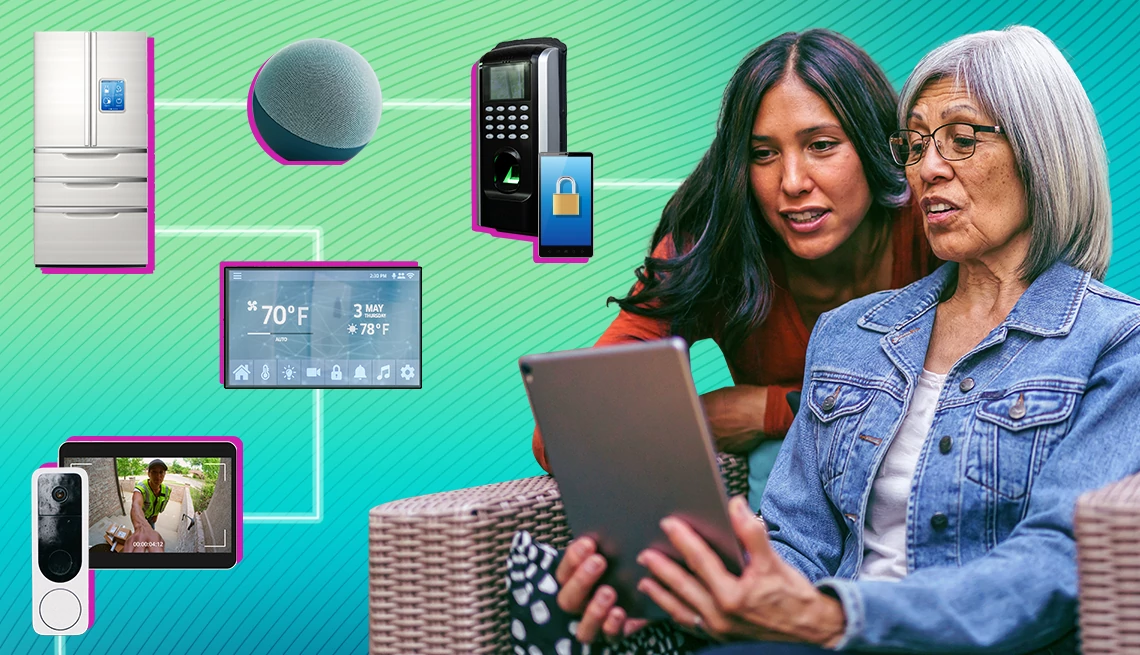AARP Hearing Center


Can an internet-connected smart home make it easier for older adults to live independently and simplify care for them?
Until now, adoption of smart home technology among older Americans has been lukewarm at best. Recent leaps, including artificial intelligence, paired with the desire of about 9 in 10 older people to stay in their homes as long as possible, make the question worth asking again.
Smart home tech encompasses smart:
- Appliances
- Cameras
- Cookware
- Doorbells
- Energy systems
- Garage door openers
- Lights
- Mattresses
- Plugs
- Security systems
- Speakers
- TVs
- Window treatments
Collectively called the internet of things (IoT), these products are considered intelligent because they connect to your home’s internet and you can control them via smartphone and computer and often by voice. But just because household products make nice with the internet doesn’t always make them more useful.
Lack of simplicity is a big stumbling block
About 1 in 5 respondents 50 and older say they don’t need smart home devices, according to a fall 2023 AARP survey. Around 1 in 10 expressed no interest at all. Some smart home products were deemed too expensive, too intrusive, too complicated or, to put it bluntly, overkill.
Consumers who purchase smart home products often don’t wonder whether individual items connect with other devices in their house or whether they might need help getting them to work. The industry is trying to solve this with a technical standard known as Matter, which has support from companies — including Amazon, Apple, Google and Samsung — that are behind the most popular smart home platforms.
“It’s still the same do-it-yourself piecemeal,” says Laurie M. Orlov, an industry analyst in Port St. Lucie, Florida. “You buy one thing and then you buy another thing, and then if you buy too many things, you have to hire [help]. We haven’t moved much past that.” Her Aging and Health Technology Watch website spotlights aging in place.
Buyers’ biggest pain point is setting everything up, says Nick Millette, product development merchant and tester at Home Depot’s Hubspace smart home platform.
“This is what I do for a living,” he says. “I’ve got 15 products I tested today and three that I am not able to get connected.”
Home security systems fill a need for older adults
Older consumers are embracing some tech, research by Parks Associates shows. The Addison, Texas, market researchers found that 24 percent of people 65 and older have a home security system, and 34 percent own at least one smart home device besides a smart speaker, such as a video doorbell, smart camera, smart door lock, smart light or smart thermostat.
“The big wrapper is around health, well-being, longevity, connectivity and care coordination,” says Ken Honeycutt, director of commercialization for Samsung Health in Raleigh, North Carolina.
Choose devices that meet specific needs, and you won’t go wrong, says Stacey Higginbotham, a Seattle-area policy fellow at Consumer Reports.
“I want [smart lights] to have circadian rhythms. I want it to work with a motion sensor easily. I want to tie it into security systems,” she says. “Figure out what you want, and then find a system that will do that for you with whatever [smart]phones you have.”



































































More From AARP
5 Ways Tech Can Help Caregivers of Dementia Patients
Wearables, smart homes, other solutions don’t work for all
6 Innovations to Help People Live Better as They Age
Safety, independence are possible by leaning into tech
AARP Smart Guide to Keeping Your Memory Sharp
22 science-backed ways to growing a healthier, happier brain, now and in the future
Recommended for You